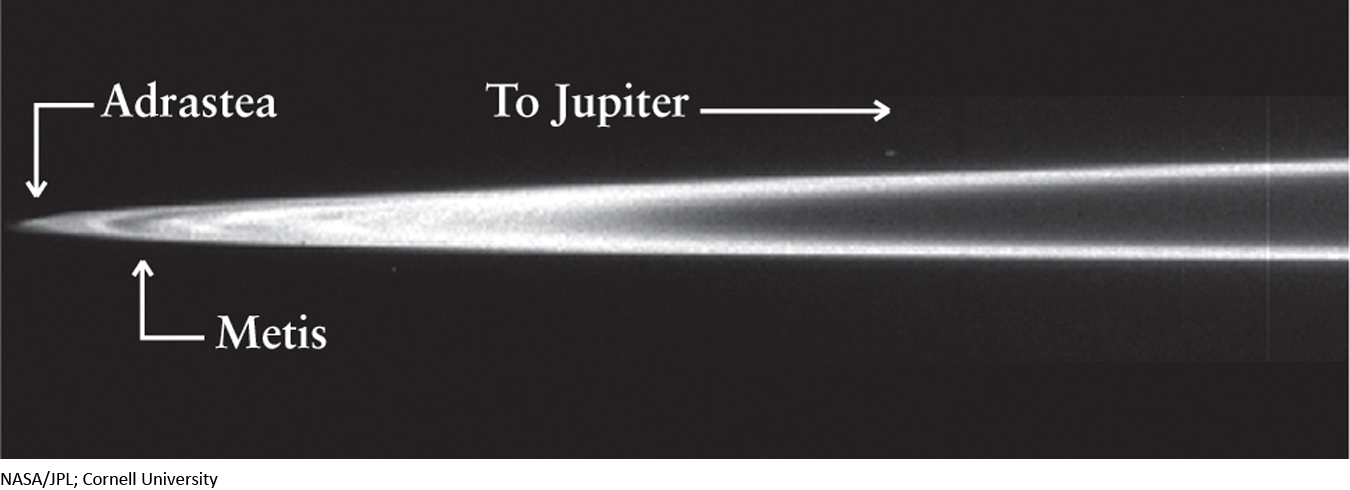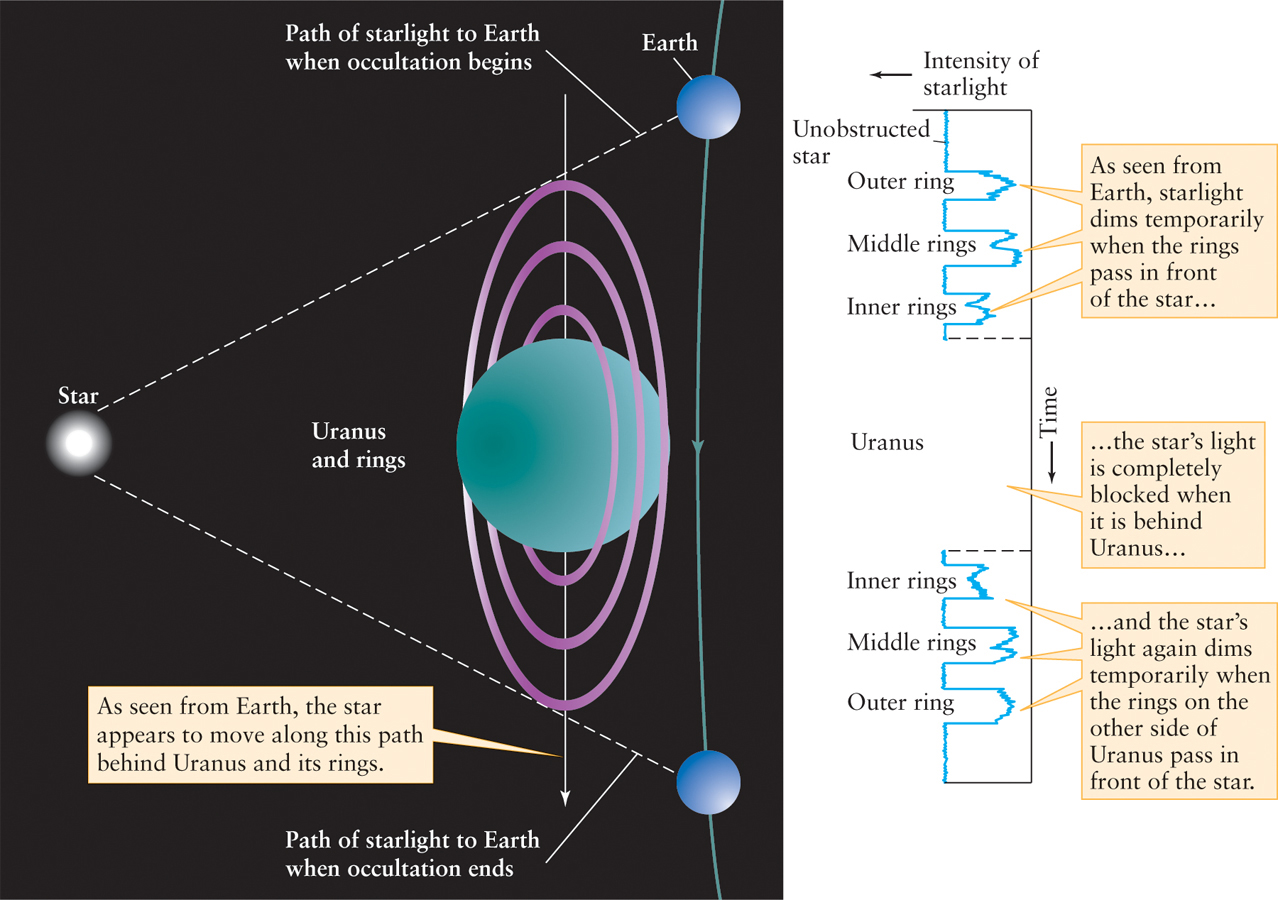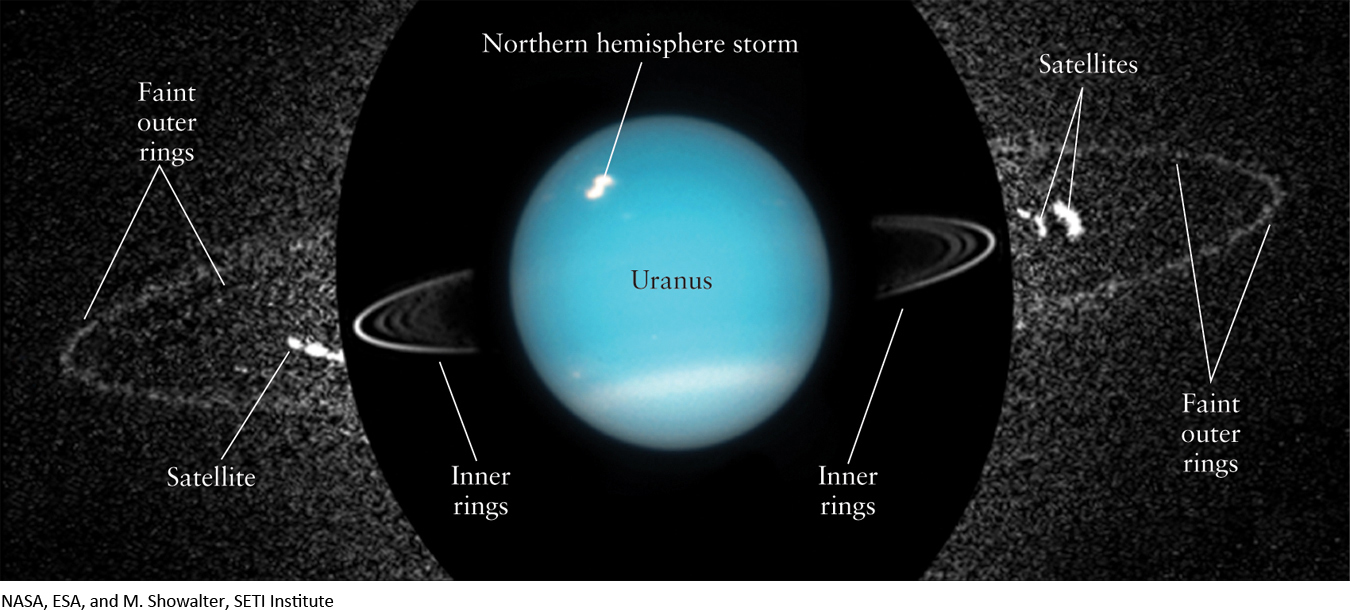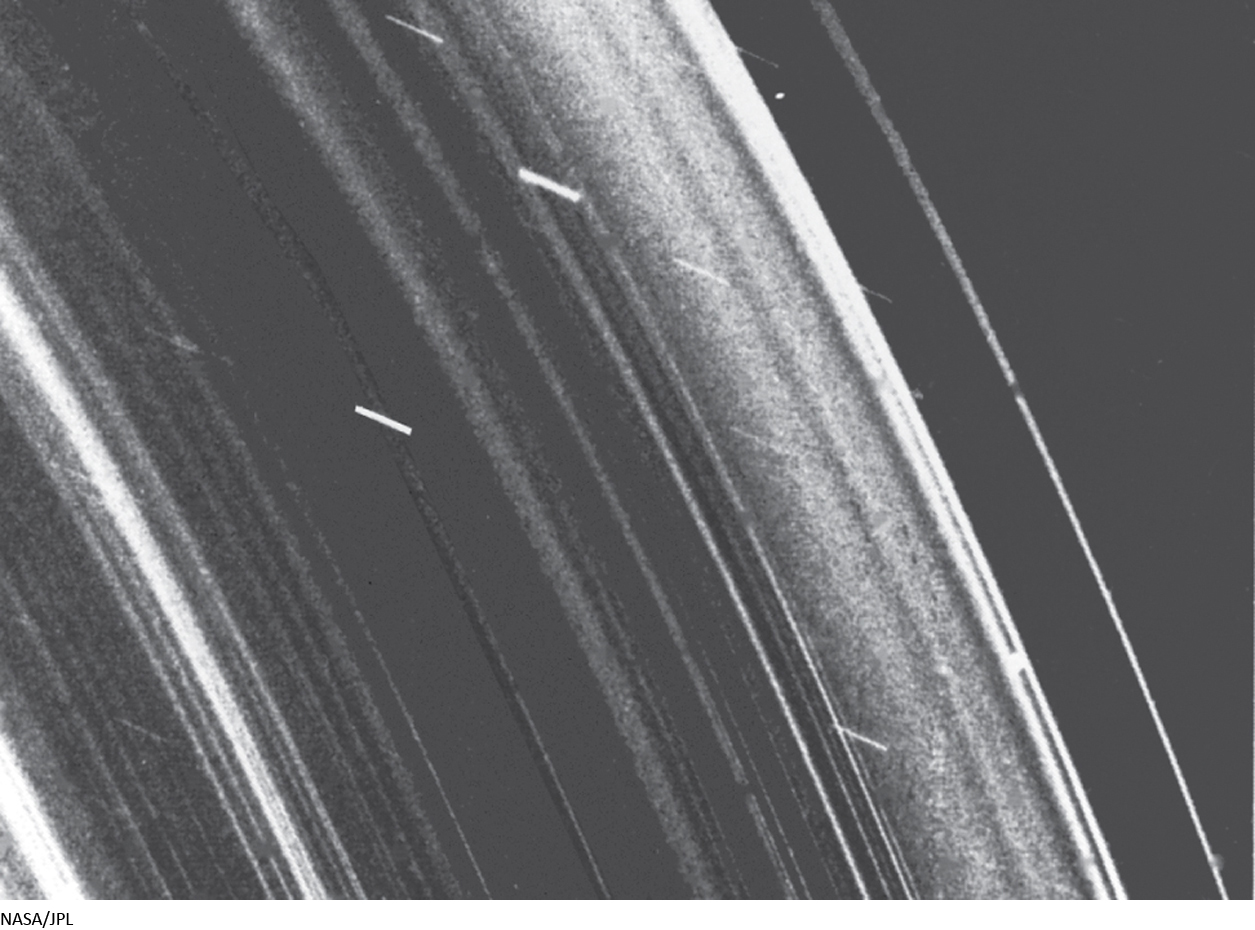7-4 All Jovian planet atmospheres are encircled by complex ring systems
When looking at images of Jovian planets showing swirling atmospheres and at striking spacecraft data that reveal the nature of their moons, it might be easy to forget one of the most fascinating and poorly understood characteristics of these outer planets. Even through a small telescope, Saturn stands out as perhaps the most beautiful of all the worlds of the solar system, thanks to its majestic rings (Figure 7-17). In this section, we explore the mysterious ring systems found around the outer planets.

Discovering Saturn’s Rings
In 1610, Galileo became the first person to report seeing Saturn through a telescope. He saw few details, but he did notice two puzzling lumps protruding from opposite edges of the planet’s disk. Curiously, these lumps disappeared in 1612, only to reappear in 1613. Other observers saw similar appearances and disappearances over the next several decades. In 1655, the Dutch astronomer Christiaan Huygens began to observe Saturn with a better telescope than had been available to any of his predecessors. On the basis of his observations, Huygens suggested that Saturn was surrounded by a thin, flattened ring. At times this ring was edge-on as viewed from Earth, making it almost impossible to see. At other times Earth observers viewed Saturn from an angle either above or below the plane of the ring, and the ring was visible, as in Figure 7-1b. (The lumps that Galileo saw were the parts of the ring to either side of Saturn, blurred by the poor resolution of his rather small telescope.) Astronomers confirmed this brilliant deduction over the next several years as they watched the ring’s appearance change, just as Huygens had predicted.
180
Earth-based views of the Saturnian ring system change as Saturn slowly orbits the Sun. Huygens was the first to understand that this change occurs because the rings lie in the plane of Saturn’s equator, and this plane is tilted 27° from the plane of Saturn’s orbit. As Saturn orbits the Sun, its rotation axis and the plane of its equator maintain the same orientation in space. Hence, over the course of a Saturnian year, an Earth-based observer views the rings from various angles (Figure 7-18). At certain times Saturn’s north pole is tilted toward Earth and the observer looks “down” on the “top side” of the rings. Half a Saturnian year later, Saturn’s south pole is tilted toward us and the “underside” of the rings is exposed to our Earth-based view.

When our line of sight to Saturn is in the plane of the rings, the rings are viewed edge-on and seem to disappear (see the images at the upper left and lower right corners of Figure 7-18). This disappearance indicates that the rings are very thin. In fact, they are thought to be only a few tens of meters thick. In proportion to their diameter, Saturn’s rings are thousands of times thinner than the sheets of paper used to print this book.
As the quality of telescopes improved, astronomers realized that Saturn’s “ring” is actually a system of rings, as Figure 7-19 shows. In 1675, the Italian astronomer Cassini discovered a dark division in the ring. The Cassini division is an apparent gap about 4500 kilometers wide that separates the outer A ring from the brighter B ring closer to the planet. In the mid-1800s, astronomers managed to identify the faint C ring, or crepe ring, that lies just inside the B ring.

181
Question
ConceptCheck 7-9: What causes Saturn’s brilliant rings to be sometimes nearly invisible and at other times easily observable with the smallest of telescopes?
Nature of Rings
Saturn’s rings are made of an indefinite number of unconnected particles or “moonlets,” or ring particles, each individually circling Saturn. Saturn’s rings are quite bright: They reflect 80% of the sunlight that falls on them. (By comparison, Saturn itself reflects 46% of incoming sunlight.) Astronomers have long suspected that the ring particles are made of ice and ice-coated rock. Voyager and Cassini spacecraft have made even more detailed infrared measurements, which indicate that the temperature of the rings ranges from −290°F (−180°C) in the sunshine to less than −330°F (−200°C) in Saturn’s shadow. Water ice is in no danger of melting or evaporating at these temperatures.
To determine the sizes of the particles that make up Saturn’s rings, astronomers analyzed the radio signals received from a spacecraft as it passed behind the rings. How easily radio waves can travel through the rings depends on the relationship between the wavelength and the particle size. The results showed that most of the particles ranged in size from pebble-sized fragments about 0.5 in. (1.25 cm) in diameter to chunks about 5 m across, the size of large boulders. Most abundant were snowball-sized particles about 4 in. (10 cm) in diameter.
All of the material in Saturn’s rings may be ancient debris that failed to accrete (fall together) into moons or, more catastrophically, objects that were pulled apart when they came too close to Saturn. The total amount of material in the rings is quite small. If Saturn’s entire ring system were compressed together to make a single moon, it would be no more than 60 mi (100 km) in diameter. But, in fact, the ring particles are so close to the gravitational churning of Saturn that they will never be able to form moons.
To see why, imagine a collection of small particles orbiting a planet. Gravitational attraction between neighboring particles tends to pull the particles together. However, because the various particles are at differing distances from the parent planet, they also experience different amounts of gravitational pull from the planet. This difference in gravitational pull is a tidal force that tends to keep the particles separated.
The closer a pair of particles is to the planet, the greater the tidal force that tries to pull the pair apart. At a certain distance from the planet’s center, called the Roche limit, the disruptive tidal force is just as strong as the gravitational force between the particles. (The concept of this limit was developed in the mid-1800s by the French mathematician Édouard Roche.) Inside the Roche limit, the tidal force overwhelms the gravitational pull between neighboring particles, and these particles cannot accrete to form a larger body. Instead, they tend to spread out into a ring around the planet. Indeed, most of Saturn’s system of rings visible in Figure 7-19 lies within the planet’s Roche limit. All large planetary satellites are found outside their planet’s Roche limit. If any large satellite were to come inside its planet’s Roche limit, the planet’s tidal forces would cause the satellite to break up into fragments.
CAUTION
It may seem that it would be impossible for any object to hold together inside a planet’s Roche limit. But the ring particles inside Saturn’s Roche limit survive and do not break apart. The reason is that the Roche limit applies only to objects held together by the gravitational attraction of each part of the object for the other parts. By contrast, the forces that hold a rock or a ball of ice together are chemical bonds between the object’s atoms and molecules. These chemical forces are much stronger than the disruptive tidal force of a nearby planet, so the rock or ball of ice does not break apart. In the same way, people walking around on Earth’s surface (which is inside Earth’s Roche limit) are in no danger of coming apart, because we are held together by comparatively strong chemical forces rather than gravity.
182
Pioneer 11, Voyager 1, and Voyager 2 recorded images of Saturn’s rings during their flybys in 1979, 1980, and 1981, respectively. Pioneer 11 had only a relatively limited capability to make images, but cameras on board the two Voyager spacecraft sent back a number of pictures showing the detailed structure of Saturn’s rings. Since entering Saturn orbit in 2004, the Cassini spacecraft has provided scientists with even higher-resolution images of the rings.
Figure 7-20 shows a closer view of the rings. To the amazement of scientists, images like the one in Figure 7-20 revealed that the broad A, B, and C rings are not uniform at all but instead consist of hundreds upon hundreds of closely spaced bands or ringlets.

Spacecraft have done more than show Saturn’s rings in greater detail; they have also viewed the rings from perspectives not possible from Earth. Through Earth-based telescopes, we can see only the sunlit side of the rings. From this perspective, the B ring appears very bright, the A ring moderately bright, the C ring dim, and the Cassini division dark (see Figure 7-20). The fraction of sunlight reflected back toward the Sun is directly related to the concentration and size of the particles in the ring. The B ring is bright because it has a high concentration of relatively large, icy, reflective particles, whereas the darker Cassini division has a lower concentration of such particles.
The Voyagers and Cassini have expanded our knowledge of the ring particles by taking high-resolution images from nearby distances. Some areas of the rings cannot be seen from Earth because they are in the shadow cast by Saturn itself.
One strategy to study the rings is to turn the spacecraft back toward the Sun and look at sunlight passing through Saturn’s rings. Using this strategy, we’ve learned that the Cassini division is not empty but contains a relatively small number of particles. This strategy to study details in the rings is quite similar to how dust particles in the air in your room suddenly become visible when a beam of sunlight passes through them. This strategy has worked well for studying many of the outer planets.
Although moons and ring systems are common around gas giants, moons with atmospheres are rare.
The color variations in Figure 7-20 suggest that the icy particles do not migrate substantially from one ringlet to another. Had such migration taken place, the color differences would have been smeared out over time. The color differences may also indicate that different sorts of material were added to the rings at different times. In this scenario, the rings did not all form at the same time as Saturn but were added to over an extended period. New ring material could have come from small satellites that shattered after being hit by a stray asteroid or comet.
In addition to revealing new details about the A, B, C, and F rings, the Voyager cameras also discovered three new ring systems: the D, E, and G rings. Figure 7-19 also shows the layout of all of Saturn’s known rings along with the orbits of some of Saturn’s satellites. The D ring is Saturn’s innermost ring system. It consists of a series of extremely faint ringlets located between the inner edge of the C ring and the Saturnian cloud tops. The E ring and the G ring both lie far from the planet, well beyond the narrow F ring. Both of these outer ring systems are extremely faint, fuzzy, and tenuous. Each lacks the ringlet structure so prominent in the main ring systems. The E ring encloses the orbit of Enceladus, one of Saturn’s icy satellites. Some scientists suspect that water geysers on Enceladus are the source of ice particles in the E ring, much as Io’s volcanoes supply material to Jupiter’s magnetosphere.
Question
ConceptCheck 7-10: If an asteroid entered a low-Earth orbit inside Earth’s Roche limit, what would become of it?
Dim Ring Systems Around Jupiter, Neptune, and Uranus
 Go to Video 7-3
Go to Video 7-3
When the Voyager 1 spacecraft flew past Jupiter in 1979, it trained its cameras not just on the planet but also on the space around the planet’s equator. It discovered that Jupiter, too, has a system of rings that lies within its Roche limit (Figure 7-21). These rings differ from Saturn’s in two important ways. First, Jupiter’s rings are composed of tiny particles of rock with an average size of only about 1 μm (= 0.001 mm = 10−6 m) and that reflect less than 5% of the sunlight that falls on them. Second, there is very little material in the rings of Jupiter, less than 1/100,000 (10−5) the amount of material in Saturn’s rings. As a result, Jupiter’s rings are extremely faint, which explains why their presence was first revealed by a spacecraft rather than an Earth-based telescope. The ring particles are thought to originate from meteorite impacts on Jupiter’s four small, inner satellites, two of which are visible in Figure 7-21.

183
On March 10, 1977, Uranus was scheduled to move in front of a faint star, as seen from the Indian Ocean. A team of astronomers headed by James L. Elliot of Cornell University observed this event from a NASA airplane equipped with a telescope. They hoped that by measuring how long the star was hidden, they could accurately measure Uranus’s size. In addition, by carefully measuring how the starlight faded when Uranus passed in front of the star, they planned to deduce important properties of Uranus’s upper atmosphere.
To everyone’s surprise, the background star briefly blinked on and off several times just before the star passed behind Uranus and again immediately after (Figure 7-22). The astronomers concluded that Uranus must be surrounded by a series of nine narrow rings. In addition to these nine rings, Voyager 2 discovered two others that lie even closer to the cloud tops of Uranus. Two other extremely faint rings, much larger in diameter than any of the others, were found in 2005 using the Hubble Space Telescope (Figure 7-23).


184
Unlike Saturn’s rings, the rings of Uranus are dark and narrow: Most are less than 6 mi (10 km) wide. Typical particles in Saturn’s rings are chunks of reflective ice the size of snowballs (a few centimeters across), but typical particles in Uranus’s rings are a few inches to 30 ft (0.1 m to 10 m) in size and are no more reflective than lumps of coal. It is not surprising that these narrow, dark rings escaped detection for so long. Figure 7-24 is a Voyager 2 image of the rings from the side of the planet away from the Sun, where light scattering from exceptionally small ring particles makes them more visible. Figure 7-23 shows the Sun-facing side of the rings.

The Uranian rings are so dark because sunlight at Uranus is only one-quarter as intense as at Saturn. As a result, Uranus’s ring particles are so cold that they can retain methane ice. Scientists speculate that eons of impacts by electrons trapped in the magnetospheres of the planets have converted this methane ice into dark carbon compounds, accounting for the low reflectivity of the rings.
Uranus’s major rings are located less than 2 Uranian radii from the planet’s center, well within the planet’s Roche limit. Some sort of mechanism, possibly one involving gravitational attraction from nearby moons, efficiently confines particles to their narrow orbits. Voyager 2 searched for such orbiting satellites but found only two. The others may be so small and dark that they have simply escaped detection.
The two faint rings discovered in 2005 (see Figure 7-23) are different: They lie well outside Uranus’s Roche limit. The outer of these two rings owes its existence to a miniature satellite called Mab (named for a diminutive fairy in English folklore) that orbits within this ring. Meteorites colliding with Mab knock dust off the moon’s surface. Since Mab is so small (just 22 mi (36 km) in diameter) and hence has little gravity, the ejected dust escapes from the satellite and goes into orbit around Uranus, forming a ring. The inner of the two faint rings may have been formed in the same way; however, no small satellite has yet been found within this ring.
Like Uranus, Neptune is surrounded by a system of thin, dark rings that was first detected when the rings passed directly in front of a distant star. Figure 7-25 is a Voyager 2 image of Neptune’s rings. The ring particles vary in size from a few micrometers (1 μm = 10−6 m) to about 30 feet (10 meters). Just as for Uranus’s rings, the particles that make up Neptune’s rings reflect very little light.

In 2002 and 2003, a team led by Imke de Pater of the University of California, Berkeley, used the 10-m Keck telescope in Hawaii to observe in detail the rings of Neptune. Remarkably, the team found that all of the rings had become fainter since the Voyager 2 flyby in 1989. Apparently the rings are losing particles faster than new ones are being added. If the rings continue to decay at the same rate, one of them may vanish completely within a century. More research into the nature of Neptune’s rings is needed to explain this curious and rapid decay.
Question
ConceptCheck 7-11: Why are Saturn’s rings easier to observe than those of the other planets?
185